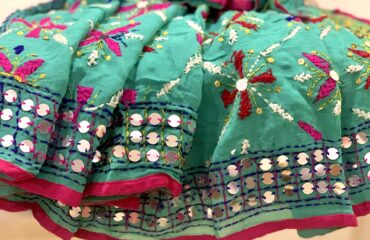Embroidery is an occupational and beloved art, and India has many embroidery techniques that are widely popular. The three I will be talking about today are Chikankari, from the land of manners, Phulkari, the embroidery practice of flowers, and Kashidakari, more popularly known as Kashmiri embroidery.
Chikankari
The beautiful art of Chikankari comes from Lucknow, and is believed to be introduced by Nur Jehan, the emperor, Jahangir’s wife. Shockingly, references of this art have been found in the 3rd century, so I think it’s safe to say that Chikankari is definitely old. Chikankari had started out as white-on-white embroidery but has now evolved into an art where various colors and fabrics are used. A Chikankari piece is created by block printing patterns of it. Then, darning stitches are embroidered along the pattern, and afterwards, it is washed to remove any excess traces of the prints peeking out. And don’t forget, in my previous blog post, I talked about how block printing is good for the environment because of its sustainability and use of organic, natural dyes. So, technically, Chikankari is a technique that’s supporting nature.
Phulkari
As mentioned earlier, Phulkari is the practice of embroidering flowers, as you may have already guessed from the name. However, Phulkari doesn’t just involve flowers in its designs, but also geometrical shapes. If you’re wondering, Phulkari is the folk embroidery of the Punjab, and is usually used mainly for embroidering dupattas, odhinis, and shawls. And here’s how you do it. First, you must draw the design you desire onto the fabric. Afterwards, just use the darning stitch to stitch along the drawing and you’re done! Phulkari is also very helpful towards supporting the environment, because the fabric that is mainly used to do Phulkari is natural-dyed khadi cloth.
Kashidakari
Kashidakari, or Kashmiri embroidery, had evolved with the utmost encouragement of the Persian and Mughal rulers. Legend has it that a Persian Sufi saint brought the skill to the beautiful city of Kashmir. Kashidakari features the Kashmiri teapot and is inspired by the scenery of Kashmir. Although, animals and humans are not featured in this embroidery. It started out as a skilled craft, but then turned into something you could just do for fun. Unfortunately, unlike Chikankari and Phulkari, Kashidakari’s ways are not nature-approved, for it is performed on cotton, wool, and silk cloth, which is such a shame.
Embroidery is an extraordinary, irreplaceable art that I truly hope will carry on in the future, with hundreds of techniques, some supportive of nature, and some that could use a bit of improvement. However, all of them are beautiful in their own ways, and I strongly encourage you to try embroidery, especially using some eco-friendly techniques. I hope you have enjoyed reading this and are thinking about trying one of these techniques out, and make sure to follow me to support Suva and our cause; saving the planet, and looking good while doing so.
Written By
Myiesha Jain
A 12-year old worried about climate change
Follow at @writeforacause

